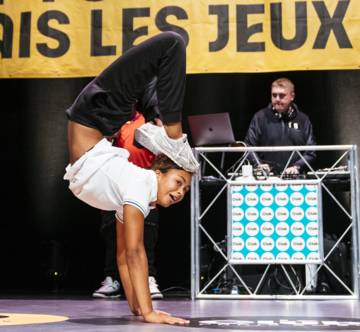We have found contents for ""
Sorry, we didn't find any results. Please ask another question.
Cette recherche n'a pas pu être traitée en raison d'un trop grand nombre de tentatives en peu de temps. Veuillez réessayer plus tard.
sur


Learn more about breaking: the sport performed by Carlota Dudek
Tuesday, 15 september 2020
It will most certainly be one of the main attractions of the 2024 Paris Games! A new discipline recently included on the list of Olympic sports, breaking (or ‘breakdancing’) was the sport chosen for one of the challenges organized by the Paris 2024 Club. Carlota Dudek, supported by the Caisse d’Epargne CEPAC, naturally took part in this event.
All the characteristics of a sporting discipline
The IOC, at its 134th session, decided to include new disciplines in the 2024 Olympic Games in order to make its program of events more attractive to a younger audience. The following day, newspapers around the world gave extensive coverage to the arrival of breaking as an Olympic sport, considering that breaking is not generally seen as a sport given its origins as a form of artistic expression.
Breaking, however, includes the features shared by all sporting activities: the physical dimension and the competitive aspect. It goes without saying that dancing is an extremely ‘physical’ activity! Dancers can justifiably be compared to high-level athletes in terms of their physical regimens, their focus on hard work, and endless hours of training. Dancing, however, is not a ‘sport’ because it doesn’t contain a competitive element. And this is precisely how breaking sets itself apart from classical, jazz, or modern dance… because a strong competitive element, the fact of challenging others, has been one if its essential features from the very outset.
Judges replace the public
Breakdance was born in the 1970s in the Black and Latino ghettos of New York City. It arrived in France in the early 80’s when it was popularized by the celebrated H.I.P.H.O.P. TV show hosted by Sydney Duteil featuring spectacular battles or competitions between rival dance teams, or ‘crews’. Originally, these crews represented neighborhoods or gangs. A dancer in one group would challenge another dancer in the rival team before giving their turn to one of their teammates. The winner of each challenge was then chosen by the crowd, whose cheers reflected the spectators’ enthusiasm for a particular performance. At present, in official competitions – and this will be the case at the 2024 Paris Olympic Games – the competitors are assessed by judges, just like in figure skating or gymnastics competitions, except that in the case of breakdancing the judges decide the winner of a duel. In the Olympic Games, the judges will pick their winning dancer on the basis of predefined scoring criteria that take account of technique, how well the moves are executed, how well the breaker expresses the music, the dancer’s energy, originality, charisma… There are moves that are executed standing up (toprock, uprock) and others down on the floor (footwork), technical elements, freezes(2), acrobatics and phases (power moves)(3). Account will be taken of all these different elements in the judges’ decisions.
The winner qualifies for the next round (as in a tennis tournament) until they reach the final. The competitions will have preliminary draws of 16 women and 16 men. Each battle lasts between 3 and 4 minutes and is played to music. This corresponds perfectly to the IOC’s desire to make the Olympic events more dynamic and more appealing to a younger audience.
As Carlota explained: “The 2024 Paris Games are a huge event for my discipline, which will be an Olympic sport for the first time (…). The 2024 Paris Games will enable us to highlight the twofold dimension of my discipline, which is both an art form and a sport. I long to give my utmost to be in the competition!”
(1) Via the Performance Pact Foundation
(2) A freeze involves halting all body motion like a frozen video image, in a frequently unstable and difficult position. It can, for example, be performed on the dancer’s hands, head, shoulder, etc.
(3) Phases or ‘power moves’ are breakdancing’s most acrobatic and aerial elements, involving repetitive circular movements of the legs.